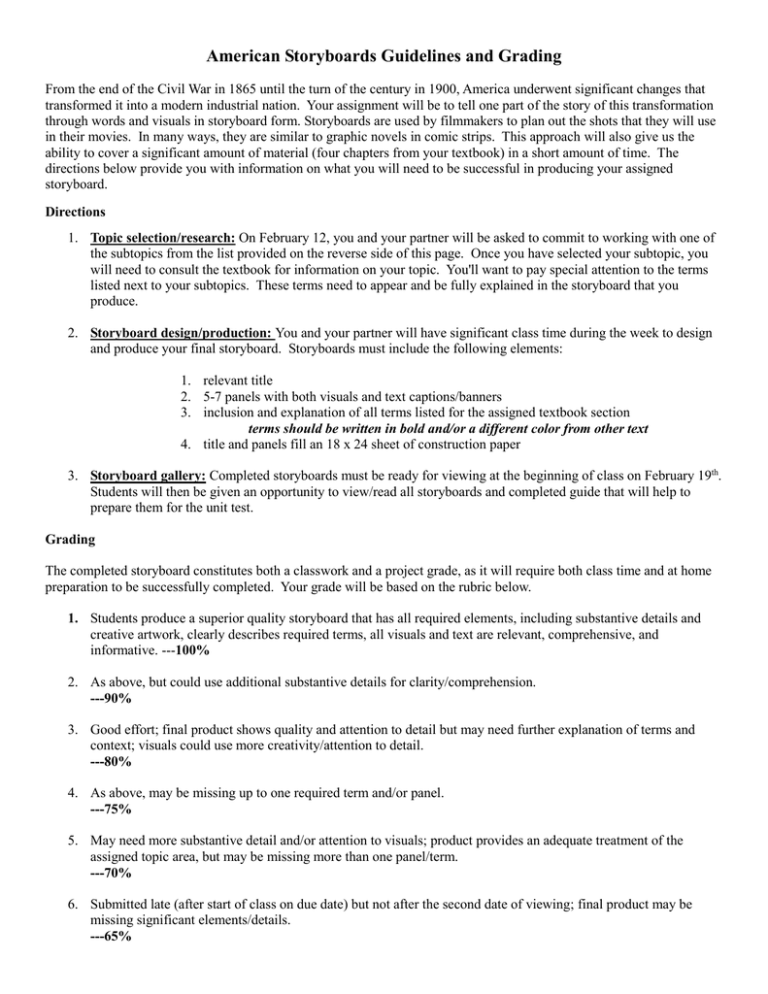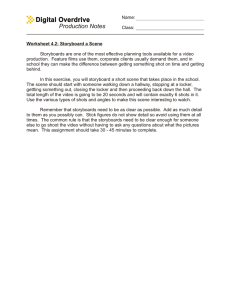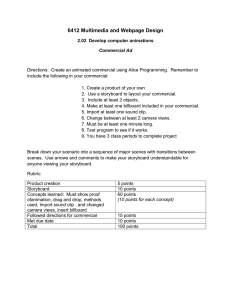American Storyboards Guidelines and Grading
advertisement

American Storyboards Guidelines and Grading From the end of the Civil War in 1865 until the turn of the century in 1900, America underwent significant changes that transformed it into a modern industrial nation. Your assignment will be to tell one part of the story of this transformation through words and visuals in storyboard form. Storyboards are used by filmmakers to plan out the shots that they will use in their movies. In many ways, they are similar to graphic novels in comic strips. This approach will also give us the ability to cover a significant amount of material (four chapters from your textbook) in a short amount of time. The directions below provide you with information on what you will need to be successful in producing your assigned storyboard. Directions 1. Topic selection/research: On February 12, you and your partner will be asked to commit to working with one of the subtopics from the list provided on the reverse side of this page. Once you have selected your subtopic, you will need to consult the textbook for information on your topic. You'll want to pay special attention to the terms listed next to your subtopics. These terms need to appear and be fully explained in the storyboard that you produce. 2. Storyboard design/production: You and your partner will have significant class time during the week to design and produce your final storyboard. Storyboards must include the following elements: 1. relevant title 2. 5-7 panels with both visuals and text captions/banners 3. inclusion and explanation of all terms listed for the assigned textbook section terms should be written in bold and/or a different color from other text 4. title and panels fill an 18 x 24 sheet of construction paper 3. Storyboard gallery: Completed storyboards must be ready for viewing at the beginning of class on February 19th. Students will then be given an opportunity to view/read all storyboards and completed guide that will help to prepare them for the unit test. Grading The completed storyboard constitutes both a classwork and a project grade, as it will require both class time and at home preparation to be successfully completed. Your grade will be based on the rubric below. 1. Students produce a superior quality storyboard that has all required elements, including substantive details and creative artwork, clearly describes required terms, all visuals and text are relevant, comprehensive, and informative. ---100% 2. As above, but could use additional substantive details for clarity/comprehension. ---90% 3. Good effort; final product shows quality and attention to detail but may need further explanation of terms and context; visuals could use more creativity/attention to detail. ---80% 4. As above, may be missing up to one required term and/or panel. ---75% 5. May need more substantive detail and/or attention to visuals; product provides an adequate treatment of the assigned topic area, but may be missing more than one panel/term. ---70% 6. Submitted late (after start of class on due date) but not after the second date of viewing; final product may be missing significant elements/details. ---65% page 2 Approved Storyboard Topics Topic (required terms listed below) Textbook Chapter/Section(s) *The Plight of Native Americans Ch. 17, (pp. 511-523) Terms: “Buffalo Bill” Cody/buffalo slaughter, Sand Creek Massacre, Battle of Little Bighorn/Custer’s Last Stand/Red Cloud/Sitting Bull, Red River War, Treaty of Fort Laramie, Helen Hunt Jackson/A Century of Dishonor, Dawes Severalty Act, Carlisle Indian School, Ghost Dance/Wounded Knee *Settling the West Ch. 17, (pp. 523-539) Terms: Pacific Railroad Act/Transcontinental Railroad, Munn -v- Illinois, Interstate Commerce Commission, Homestead Act/homesteaders, Comstock Lode/Klondike gold rush/Joseph McCoy/Chisholm Trail/cowboys, Bonanza farms/Oklahoma land rush, Frederick Jackson Turner, Conservation/Yellowstone National Park/John Muir/Sierra Club *Rise of Corporate America Ch. 18, (pp. 544-557) Terms: Features of Industrial Manufacturing, Vanderbilt/Railroads, Carnegie/Bessemer/Steel, Rockefeller/Standard Oil, Edwin L. Drake, Interstate Commerce Act, Sherman Anti-Trust Act, Vertical/Horizontal Integration, US -v- E.C. Knight Company, Alexander Graham Bell, Thomas Edison, J.P. Morgan/G.E/Westinghouse *Factories and the Work Force Ch. 18, (pp. 560-573) terms: The Grange, Farmers’ Alliances, Populism, Panic of 1893, bimetallism, gold standard, Gold Bugs, Silverites, William Jennings Bryan, Election of 1896 *Life in the City Ch. 19, (pp. 576-582, 591-596) terms: Edwin L. Drake, oil, Bessemer process, steel, Brooklyn Bridge, skyscrapers, Thomas Edison, electricity, typewriter, Alexander Graham Bell, telephone *Working Class Politics and Reform Ch. 19, (pp. 583-591, 596-604) terms: Transcontinental Railroad, time zones, George M. Pullman, Credit Mobilier scandal, Granger laws, Munn v. Illinois, Interstate Commerce Act *Political and Economic Upheaval Ch. 20, (pp. 609-617, 627-629) *The Populists and Time for the People Ch. 19, (pp. 617-629) AMERICAN STORYBOARDS: GALLERY NOTES Name: _____________________________ Please use the time provided in class today and during the next class period (half of the block) to take notes on the storyboards produced by your classmates. Pay special attention to terms in bold (the same ones listed on your American Storyboards assignment sheet). You might even want to summarize your own storyboard since you will be able to use this set of notes on the upcoming “Industrial America” unit test. The completed gallery notes will be turned in with the unit test and will constitute a class work credit. The Plight of Native Americans Who is Sitting Bull? Leader of the Hunkpapa Sioux tribe, he led his people during years of resistance to US gov’t policies, he defeated Custer and US troops at the battle of Little Bighorn Who was killed at the Battle of Little Big Horn? George A. Custer What happened at Sand Creek? Led by John Chivington, a group of white men attacked a peaceful Cheyenne village and killed 150 men, women and children What is the Dawes Act? Divided American Indian tribal land into allotments for Native Americans, those who accepted the land could become citizens, the act was an attempt to “Americanize” Indians What is the idea of blending Native Americans into American culture? Assimilation Cattle Trails & Cowboys What was the type of cattle used on the long drives? Cows, Longhorns Where did the term cowboys originate from? Spanish word “vaquero”, meaning “a boy who tends cows” What did Joseph McCoy do? A famous longhorn farmer, he is best known for promoting transport of longhorns from Texas to the east coast Who invented barbed wire? Joseph Glidden Homesteaders What act provided farmers with free land from the Federal Government? Homestead Act What are Homesteaders? Small farmers living off the land; self-sufficient What is the term for African-Americans who left the south to settle and farm in the Great Plains? Exodusters What act created agricultural colleges in the mid-west? Morrill Act of 1862 The Populist Movement What group of people are most closely associated with the Grange Movement? Farmers What is the main focus of Populism? Movement of the people; established People’s Party 1892; goal was to give the people greater voice in government What is the idea of backing paper money with both silver and gold? Bimetallism What is the Gold standard? Backing dollars solely with gold; “gold bugs” strongly supported the gold standard Who is William Jennings Bryan? Known as “The Great Commoner”, he was a dominant force in populist wing of Democratic party; anti-gold standard Inventions & Industry Who perfected a means to retrieve oil from the ground? Edwin L. Drake The Bessemer process is used for what? Making iron into steel What did the stronger steel help build (it helped with the growth of cities)? Skyscrapers, bridges, railroads, etc. Who invented the light bulb Thomas Edison Who invented the typewriter? Christopher Sholes Alexander Graham Bell is most closely associated with which invention? Telephone The Age of Railroads What was the Transcontinental Railroad? First railroad built that crossed the nation from Atlantic to Pacific Time zones were introduced to benefit which group? Train travelers and railroad companies Who was George M. Pullman? American engineer and industrialist; founder of the sleeping car (railway passenger cars with beds for passengers) What was the Credit Mobilier scandal? Scandal involving railroads, Congressmen distributed cash bribes and discounted Crédit Mobilier shares of stock to other congressmen, in exchange for votes and actions favorable to the Union Pacific; the scandal caused public distrust of Congress and federal government Big Business Andrew Carnegie is most closely associated with which industry? Steel industry What business strategy did Andrew Carnegie use? Horizontal integration – merging of companies that make similar products to make one larger, more powerful company John D. Rockefeller is most closely associated with which industry? Oil industry What is a “Robber baron”? Businessmen (such as Carnegie and Rockefeller) who engaged in unethical and monopolistic practices What act outlawed the formation of trusts? Sherman Antitrust Act What is Social Darwinism? Natural selection in society; the rich were meant to be rich and the poor were meant to be poor The Labor Movement National Labor Union (NLU) was formed by which group? Skilled workers Who is Samuel Gompers? President of American Federation of Labor What is the Haymarket Riot? Protesting of police brutality; many killed What is the Homestead Strike? Labor unions on strike; Carnegie’s plant; though Unions were defeated, this was one of the first times the public gave support to the workers, rather than big businesses The New Immigrants A new immigrant coming in from Europe would go through which place? Ellis Island, New York A new immigrant coming in from Asia would go through which place? Angel Island, San Francisco What does the term Melting pot mean? Mixture of different races and cultures living together What is the idea that America is better than everyone else and there should be a limit on immigration? Nativism, Nationalism What is the Gentlemen’s Agreement? Restricted Japanese Immigration Urbanization What is the idea of Urbanization? Rapid growth in construction, cities growing What is the process of assimilating people into a dominant culture? Cultural Assimilation What were some of the problems w/ Urbanization? Insufficient water supply, smoke, sewage, crowded and unsanitary living conditions, etc. What is a Settlement house? Community center in the slums that provided assistance to poor Who created Hull House? Jane Adams What was the Social Gospel Movement fighting for? Poor families Science, Urban Life, and Mass Culture Who invented the first airplane? The Wright Brothers What did George Eastman invent? Kodak Camera What different recreational activities were available to people living in the cities? Amusement parks, baseball games, theater, vaudeville shows, etc. What did Mark Twain write? Adventures of Huckleberry Finn and Adventures of Tom Sawyer African-Americans Who was the founder of the Tuskegee institute? Booker T. Washington What did W.E.B. Du Bois do? Created the Niagara Movement, a civil rights organization est. 1905 Who was the women that became a civil rights activist and fought against lynching in the South? Ida B. Wells What is Segregation? Separation of races What laws were created to separate the races? Jim Crow Laws What court case established the idea of separate but equal? Plessy v. Ferguson

